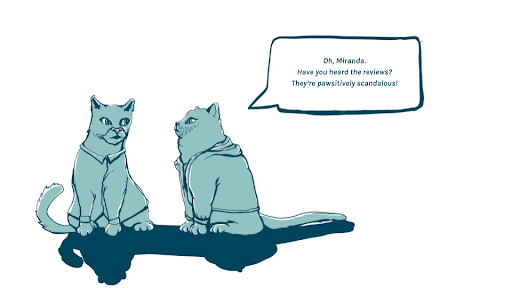Written by Lauren Bergeron
February 27th, 2022
10 Tips for Lifestyle Copywriting

Lenses line the carpet, each one craning, vying for a chance to capture the next VIP on camera. Next up, sporting a sleek ensemble, adorned with sequined letters, commas, and quotation marks is… you.
As a lifestyle copywriter, you, my friend, are the Meryl Streep of the copywriting world.
Yeah, you’re a one-of-a-kind wordsmith. What sets you apart from other creative minds in the industry is your ability to step into nearly any role and completely knock the pants off of anyone who’s watching.
But even the finest thespians can benefit from a few pointers. To help you refine your craft, we’re pulling back the curtain to reveal ten of our top tips for lifestyle copywriting.
Scene one. Take one. Action!
#1 Read The Script
While improv is certainly a useful skill to be able to tap into, you may not win any awards with clients if you try to interpret their character in whatever way you please. That’s why you’ll want to start by carefully reading through the creative brief—AKA the script. Here, you’ll find many of the brand’s preferences including:
- Logo and color palette
- Imagery
- Target demographic
- Formatting preferences
- Brand voice
While Oxford comma use and capitalization are certainly important, as a lifestyle writer, you’ll want to pay particularly close attention to the audience and voice. Who will your copy have to relate to and what language should you use to approach them? We’ll go more into detail on that later, but for now, focus on familiarizing yourself with the role at hand by reading through the script.
#2 Make Your Own Blooper Reel
What you see on the big screen may appear to have been impeccably executed, but that doesn’t mean the actors nailed each scene on the first try. In fact, there are likely a number of laughable outtakes lurking behind the scenes of even the most esteemed Oscar-winning flicks.
The same goes for copywriting—well, sort of.
While most actors try to avoid flubbing lines on set, you, dear lifestyle writer, are encouraged to let loose. Before diving headlong into an assignment, open up a blank document or a blank page in your notebook and paint it from top to bottom with the best intentional bloopers your creative mind can muster up.
Start by focusing on what’s at the core of your project. Soy candles, let’s say. From there, you’ll participate in what might resemble a boisterous family game of charades in which each player shouts answers from every corner of the room with unabashed conviction.
“SANDALWOOD!”
“TEALIGHTS!”
“SNIFF-INDUCED SENSORY OVERLOAD!”
Unlike during family game night, there are no wrong answers in this round. Sure, you might end up squashing a majority of the ideas, but by allowing your mind to wander freely in every creative direction, you might just find yourself with a few gems that become the essential pieces of the best slogan, blog post, or email sequence you’ve ever written.
#3 Get Into Character
Now that you’ve gotten a slew of wacky but worthwhile words and phrases out of your head, it’s time to focus on stepping into your character. Remember to refer back to the script to refresh your memory.
Who will you morph into today, Meryl?
Will you play the 30-something digital nomad who can bargain for locally made mementos (in five languages, no doubt) and provide savvy, trustworthy advice on all things luggage-related? The impossibly cool yet surprisingly approachable next-door neighbor who has a knack for recommending lifestyle shoes to wear for just about any occasion? Or the versatile, adaptable career actress who can step onto any film set with unimaginable grace and prowess? Oh, wait…
Just like Meryl, brands may strive to be many things:
- Conversational
- Witty
- Positive
- Warm
- Self-assured
- Authoritative
Follow the client’s cues, get into the right mindset to embody that character, and let their voice shine through in every line of your copy.
#4 Appeal to Your Audience
Perhaps just as important as who you are (or whose voice you’re trying to emulate) is who’s buying tickets to your show. In everyday life, we tend to sink into different registers of speech depending on who we’re talking to, whether it be a colleague, friend, family member, or child—oftentimes without even realizing we’re doing so.
Good lifestyle copywriting, however, makes the conscious decision to shape language into the ideal mold for a particular audience. You might consider questions such as:
- What motivates this audience?
- Who might they trust to help them make an important decision? And why?
- What language or references will appeal to their sensibilities?
The brands you’re working with have probably already taken these factors into consideration and will likely provide you with the direction you need. As you write your copy, make sure the contents of your project aren’t shouting out aimlessly into the void but, rather, are enticing a particular demographic to line up outside the box office.
#5 Break The Fourth Wall
As with any theatrical performance, your copywriting should be entertaining, convincing, and perhaps even incite a few laughs. But on this stage, you can—and should—break the fourth wall. Your audience members are not simply theater-goers but, rather, a group with whom you are engaging in conversation.
In short, you (yes, you) should not be afraid to tap into the power of the second person.
Whittle down the larger concept of your audience into an individual person who has an identity, a personality, maybe even a name and face. Slap as many specifics down on a sticky note as possible, attach it to the corner of your monitor to keep them fresh in your mind, and speak directly to them as you write.
#6 Put On a Convincing Show
What we often love about our favorite actors is that, for a period of time, we truly believe they’re someone else. In some cases, it’s their meticulously executed accent that makes it nearly impossible for us to believe that they were born and raised anywhere except South Boston. For others, it’s their knack for eliciting sorrow or pain over a loss they’ve never experienced.
The key to their success? Research and careful practice.
Lifestyle copywriting may be more casual and conversational than other genres, but that doesn’t mean it’s devoid of substance and fact. You can go from telling a compelling story to whisking your audience away to an entirely new world by incorporating sound research that allows your reader to buy into what you’re saying.
#7 Involve Yourself in the Scenic Design
As a copywriter-actor extraordinaire, your job goes deeper than simply delivering lines. On this indie film set, you might have to tap into some set design skills, too. In copywriting, as in film production, some amount of “wow factor” comes from carefully designed, well-built scenery, which allows you and your crew to shine the spotlight on the product or service your client is trying to promote.
Beyond the functionality of backdrops and furniture pieces, a well-designed set creates a realistic picture of an imagined world and the characters that inhabit it.
As a copywriter, you’ll want to show what your audience’s life might look like after making the decision to invest in the company’s product or service—what might happen if they stepped foot into this created world. This will look different for each film production, or client:
- For a luggage company – Yes, exterior pockets and wheel maneuverability are practical features to highlight when writing for a stylish luggage company, but is that enough to convince a consumer to click “Add to cart”? Instead, build the scene and place them in it: a stress-free day at the airport with a compact suitcase that allows the traveler to use their hands to sip coffee and complete the daily crossword on their layover.
- For a mattress company – Zonal support and shock absorption? Definitely a mattress must-have. But waking up feeling like a million bucks and blissfully unaware of the fact that your partner tossed and turned for the better half of the last eight hours? Now that’s what dreams are made of.
Master the art of set design and you’ll have copy that dazzles and drives conversions.
#8 Leave the Archetypes to Rom-Coms
Humans are a complex bunch. We can just as easily find ourselves debating our friends about the fashion faux pas committed by one of the latest contestants of The Bachelorette as we can become enthralled in peeling back the layers of Nietzsche’s thoughts on nihilism.
To that end, don’t assume your audience is full of one-dimensional characters. Avoid making hyperbolic or overgeneralized statements within your copy that relegate your readers to a single category. Instead, err on the side of inclusivity. Otherwise, you might be the next target of a projectile rotten tomato (or a bad review on the website of the same name).
#9 Leave Your Audience Feeling Inspired
Have you ever left the movie theater with a newfound excitement for life? Perhaps Hoosiers encouraged you to take the leap back into team sports or the latest rom-com on Netflix gave you the nudge you needed to get back out into the dating world.
So much of lifestyle copywriting is designed to inspire your audience in the same way. When you work with brands in the industries of health and wellness, travel, or even style, one of the primary goals is to empower your audience to make a positive change in their everyday life. Speak to what might motivate them, empathize with them, and be their hype-person who helps guide them to a feel-good decision.
#10 Be Your Own Critic

A World-Class Performance Sullied by an Improper Use of “They’re”
Don’t wait for the ratings to come in and don’t let that headline appear as the subject line of an email from your editor. Before premiering your latest work, make sure it’s as polished as possible. This means reading through to catch any elusive spelling or punctuation mistakes, of course. But it also means assessing your work for factors like:
- Appropriateness and relevance
- Logical organization and flow
- Style and formatting
- Keyword implementation
Now’s also a good time to keep your voice in check. Have you gone a little too heavy on the puns? Not heavy enough? Pick your best moments and edit out any others that may be interrupting the flow of the piece.
Copycat: Your Red-Carpet-Ready Felines
Another limousine pulls up. The door opens slowly. A hush falls over the crowd of frenzied fans and paparazzi. Which celeb is stepping foot on the scarlet, star-studded aisle?
Is that—? Could it be—?
A paw!
Suddenly, a band of debonair felines emerges from behind the open door, pens tucked behind each of their tufted ears.
Copycat.
Renowned for our singular storytelling, captivating copy, and well-polished whiskers, Copycat is your in-house writing team. From lifestyle to technical, web content to white papers, this is one performance you simply won’t want to miss.
Alright. We’re ready for our close-up. Get your free ticket to the show today.